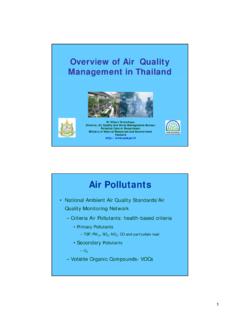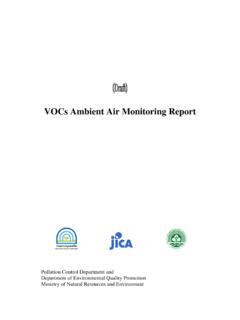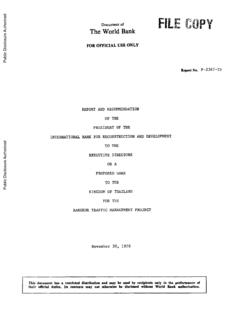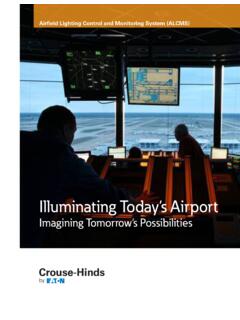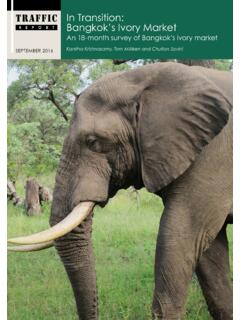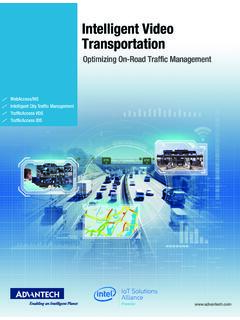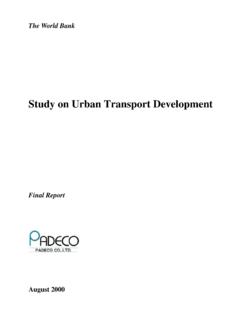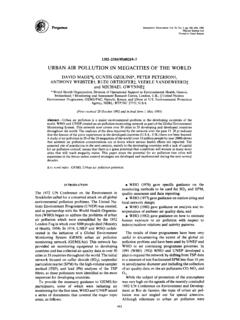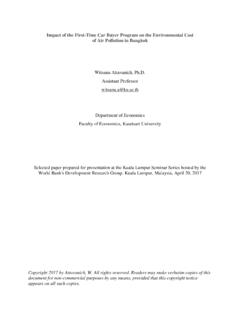Transcription of Air Pollution and Traffic Measurements in Bangkok Streets
1 Asian J. Energy Environ., Vol. 3, Issues 3-4, (2002), pp. 185-213 Copyright 2004 by the Joint Graduate School of Energy and Environment 185 Air Pollution and Traffic Measurements in Bangkok Streets S. T. Leong *, S. Muttamara and P. Laortanakul Urban Environmental Engineering and Management Program, School of Environment, Resource and Development, Asian Institute of Technology, Box 4, Klong Luang, Pathumthani 12120, Thailand. * Corresponding author: (Received : 16 October 2001 Accepted : 30 April 2003) Abstract: Ambient air quality and Traffic density Measurements were conducted during January to December 2001 at four air monitoring sites in Bangkok Metropolitan Region (BMR).
2 The ambient air pollutants included carbon monoxide (CO), particulate matter (PM10), nitrogen dioxide (NO2), sulfur dioxide (SO2), ozone (O3) and benzene. The diurnal variations of air pollutant levels were generally identical to the corresponding Traffic volume patterns during rush/non rush hours and day/night times. Average air pollutant concentration during weekday was found to be higher than during weekend. The air pollutant concentration was related to the Traffic flow pattern and human activities. The test result showed vide variations between air pollutant concentrations and with Traffic characteristic, street geometries Shing Tet Leong, S.
3 Muttamara and P. Laortanakul 186 Asian J. Energy Environ., Vol. 3, Issues 3-4, (2002), pp. 185-213 and meteorological parameters. Most of the air pollutant concentrations showed indicative correlation with Traffic density. However, there was a relatively smaller correlation between average hourly concentrations of sulfur dioxide and ozone and Traffic densities. The finding shows that the average air pollutant concentrations for the three urban sites are noticeably higher than the suburban site. Similarly, the Traffic speeds were very well correlated with Traffic densities. Lower Traffic speeds were observed among station with slow moving Traffic (high Traffic density) while higher Traffic speeds were found among station with fast Traffic movement.
4 Our analysis revealed that an obvious way to reduce the build-up of pollutant concentration on Bangkok Streets would be to speed up the flow of Traffic and prevent long periods of idling in congested Streets . Keywords: Bangkok , Benzene, Carbon monoxide, Nitrogen Dioxide, ozone, Particulate matter, Sulphur dioxide. Introduction The Bangkok metropolitan area (1,569 km2) with a total population of about million and registered vehicles of more than million (1999), is experiencing progressively intensified air Pollution problems associated with high levels of vehicular exhaust emission. Vehicle ownership in Bangkok is estimated at approximately 400 vehicles per 1,000 residents.
5 Air Pollution and Traffic Measurements in Bangkok Streets Asian J. Energy Environ., Vol. 3, Issues 3-4, (2002), pp. 185-213 187 Rapid growth of the motor vehicle population, coupled with poor engine maintenance, no requirement to fit catalytic converters and continued utilization of unleaded gasoline emits a significant quantity of air pollutants such as hydrocarbons, particulate matter (PM10), carbon monoxide, sulphur dioxide, nitrogen oxides, benzene and black smoke from diesel vehicles (Muttamara, et. al, 2000). The Pollution Control Department, Thailand (Wangwongwatana, 1999) reported that dirty air severely aggravates the symptoms of many kinds of asthma in Bangkok Metropolis.
6 Inhalation of particulate matter (PM10) poses a range of health risks, including increased respiratory problems and disease, breathing disorders and premature death. Elevated levels of carbon monoxide can impair human health causing harm to the cardiovascular and nervous systems. Benzene represents a special case due to its toxicity and its carcinogenic effect. Long-term benzene inhalation exposure as low as ppm (1 g/m3) can result in the development of acute leukemia (WHO, 1996). In view of the importance and complexity of the problem, current understanding of vehicular air Pollution and its impact on the environment is extensively studied by many European and North American countries (Elsom et.)
7 Al, 1996). However, many recent models of roadside air Pollution are designed for American and European cities and are clearly inappropriate for application to Asian cities (Okamato et. al., 1990). In addition, Shing Tet Leong, S. Muttamara and P. Laortanakul 188 Asian J. Energy Environ., Vol. 3, Issues 3-4, (2002), pp. 185-213 lack of suitable monitoring data has further hindered the use of these models. Consequently, there is considerable interest in estimating roadside air pollutant emissions and their fate in the environment (Jones et al., 2000). Although many studies on the air Pollution have been investigated in Bangkok , only few so far have focused on the relationship between Traffic density and air pollutants in ambient air quality.
8 Hence, this present study delineates the apparent trends of Traffic density, with the aim to improve our present knowledge of the levels of various air pollutants from vehicular emissions, which might prove useful in the management of air quality in Bangkok Metropolis. Materials and Methods 1. Ambient Air Quality Measurement Four street sampling stations in the Bangkok Metropolitan Region (BMR) were chosen based on Traffic density, flow conditions and wind speed. Individual locations of sampling stations are described in Figure 1. At all of these sites, the measured air pollutants were particulate matter (PM10), carbon monoxide (CO), nitrogen dioxide (NO2), sulphur dioxide (SO2), ozone (O3) and benzene.
9 Field Measurements of air pollutant levels in Bangkok Streets were spread over the period from January to December, 2001. In each monitoring station, on-line analyzers were used to monitor continuously various air pollutants and the data recorded for sessions of hourly, daily (weekday), weekend and monthly. The system provides four Air Pollution and Traffic Measurements in Bangkok Streets Asian J. Energy Environ., Vol. 3, Issues 3-4, (2002), pp. 185-213 189 types of selectable data: momentary values, integrated values, moving averages and simple averages. Automatic compensation for ambient pressure assures reliable data regardless of the weather or the monitoring location.
10 The influence from interference components is minimal and results are very stable over long periods of measurement. In addition, both ambient air monitoring and Traffic flow counting were determined simultaneously over 24-hour periods and was used to identify the rush and non-rush periods. Particulate Matter (PM10) Particulate matter was analysed by an Ambient PM10 Monitor (Graseby-FH621-N1). The system uses beta ray-absorption to measure particulate matter under 10 m in size. A glass-fibre filter tape collects the particulate matter. Oversize particles are filtered out by cyclone filtration. The intensity of beta rays are detected by a plastic scintillator.
